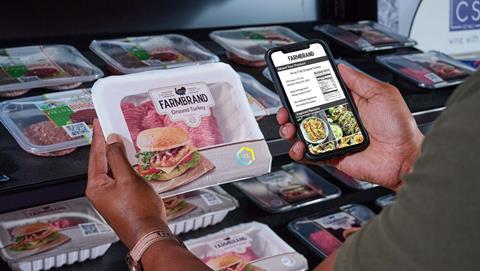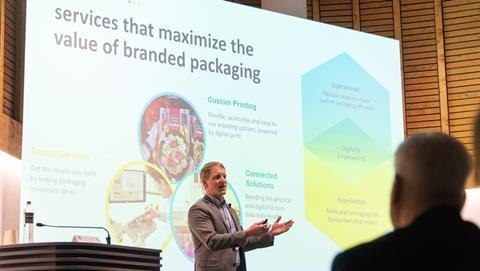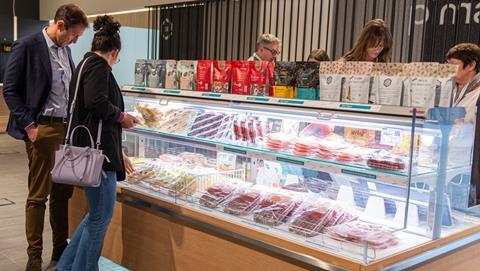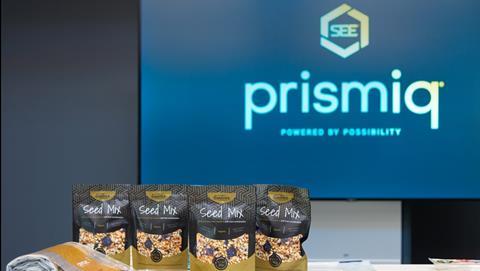
On the 15th-16th March Sealed Air held its PACK DIGITAL event in Milan ahead of the launch of its prismiq brand, a portfolio of solutions for design services, digital printing and connected packaging. Frances Butler reports.
The event on the 16th consisted of a series of talks including representatives from companies such as HP and Adobe and presentations from multiple Sealed Air representatives. It was held at the company’s Packforum venue which featured an area displaying various types of packaging in a supermarket setting, such as Cryovac vacuum packs for meat and cheese products, packs for sliced food products and resealable packs for dried fruit and pet treats.
It began with a few words from Sealed Air’s digital packaging and design director Alessandra Secchi, who stated the company’s aim to become a “digitally-driven company driven by automation and sustainability”, developing solutions to protect goods and food in a sustainable way. This was elaborated on by vice president of global design solutions Joe Lambert, whose talk entitled ‘The Digital Revolution’ expanded on prismiq’s applications, such as custom printing, connected solutions (such as automation and ways to connect with consumers) and design services (such as online design tools and online consumer feedback).
Lambert said having a ‘digital twin’ for packages allows customers to trace packages through digital means and extends the supply chain up to the product reaching the consumers’ home and end of life recycling. He added enabling consumers to scan packaging and link to digital services through a physical product helps companies connect with consumers and show them what causes are important to the company, what actions are being taken towards those causes and maintain transparency.
The next speaker was Ben Davies, founder of product intelligence platform VYPR, designed to give consumers a voice in the design process. He highlighted cost, time, product performance, and physical and resource waste as key issues during product development, but most importantly return on investment.
Davies emphasised the lack of accessible consumer insight to make decisions about what to launch, at what time and at what price point. He said:
“Retailers need to be launching less, doing it better and having the consumer voice throughout the process.”
He added that “you need technology centric ways to get the consumer voice (…) price testing is really key. It’s not about setting the price point for a product, it’s about seeing how much value consumers are seeing in products.” He explained the concept of an ‘agile’ system for product development instead of a ‘waterfall’ system: using a “test and learn” approach to gain regular feedback from consumers throughout the testing process and focusing on further development and testing of designs based on this feedback before launching anything.

On the use of digital design services, Adobe’s principal cloud consultant Matteo Oriani spoke about the Adobe Experience Cloud and how it supports prismiq. It enables design teams to share their work across apps (such as Photoshop) inside and outside the company, with colleagues, customers and stakeholders. Photorealistic substance materials can be used during the design process and different materials can be tried out and changed in real time, as well as the option to build a virtual set to show the packaging in its intended environment.
Oriani added that customers and stakeholders can see the design process from digital staging to reality, as it can be shared through photos and videos and the product can be viewed from various angles and in 3D, which he claimed reduces the carbon footprint compared to traditional photoshoots.
Designs can be moved from the desktop to the Creative Cloud to be reviewed and edited within the browser, meaning designs can be checked with the customer without the need for practical aspects. He stated there is the ability to batch render designs which can then be adjusted and edited for different colours and materials.
Next to speak was Abel Sanchez, EMEA (Europe, the Middle East and Africa) leader of brands at HP, who focused on co-creation and personalisation of products, stating HP’s aim to “humanise our technology”. He began by asking the audience:
“From 1-10, how much do you know about digital print?”
Sanchez pointed out some advantages of digital printing: the ability to print as soon as you have the design you want; the convenience of being able to print “what you want when you want”; and he claimed “you can save 30% of your packaging waste in your supply chain”.
Sanchez emphasised the importance of personalisation in packaging, particularly when it comes to the audience’s age and personalisation at scale. He added that the younger the audience are the more they are interested in these experiences and stated that “consumers are willing to pay at least 20% more” for personalisation.
He also outlined aspects of personalisation at scale, such as strategic production, hyper customisation and co-creation with consumers. He gave examples of ‘Mindful Materialism’ and using the bonds between people for personalised packaging, such as Kellogg’s Mwell prebiotic which featured recipes created by consumers on the packs; Ferrero’s marketing strategy for its Nutella ‘2 of a kind’ campaign which meant 2 consumers could have 2 of a certain design on its jars; and its music themed campaign with different years featured on the packaging, where consumers could scan a QR code to hear music from that era.
Focusing on closed loop recycling with product digitalisation, Curt Schnaker of Schnaker Consulting was next to speak. He began by discussing the proposed revisions to the EU Packaging and Packaging Waste Directive, particularly the requirement by 2030 for all packaging to be designed so that it can be recycled and for manufacturers to ensure it is recycled “at scale” by 2035.
Schnaker stated that automated sorting is required to achieve the scale needed for recycling, which he said is a complex ecosystem requiring everyone to work together. He also said smart packaging can enable recycling through on-pack identification, the use of a cloud-based platform and features such as QR codes, NFC (near field communication) and RFID (radio frequency identification). He added that with smart packaging, serialisation can be used to track events through the life cycle and for recall, and it’s critical that the platform has the ability to digest data so that inferences can be drawn and analysed by the stakeholders involved.
Schnaker emphasised the expected timeline of 18-24 months for the expected revisions to be coded into law by the EU, and concluded:
“It’s going to happen a lot faster than you might think, and now is the time to think about it.”

Prismiq Session 1: Smart packaging
Heading into the afternoon, the attendees broke into groups for sessions based on the three main areas of prismiq: design services, smart packaging and digital printing. The first session focused on smart packaging and started with a presentation from Samantha Murphy, marketing manager at Foxpak Flexibles (part of Sealed Air).
Murphy outlined how packaging can be used as a marketing tool, such as using a ‘digital twin’ for the physical product through a QR code printed on the packaging – if a brand knows consumers are conscious of the ethical implications of their purchases, it will allow the consumer to trace the product back to its source. For demonstration purposes, Murphy gave the example of a fictional fish company whose packaging included a QR code, which when scanned gave the consumer details of how the fish was caught, where and when it happened and who caught it.
Highlighting the importance of using packaging to increase brand awareness, she gave a second example of 3 product lines in collaboration with a celebrity chef, encouraging consumers to develop recipes for all 3 with a QR code on the brand’s packaging for the consumer to scan and receive instructions on how to submit their recipe creations. As a second step, she suggested the company could run a competition asking for input, providing three recipe designs and asking consumers to help choose the final one, with the winning design being printed on the packaging.
Lastly, Murphy suggested how to create brand value and generate demand through limited edition products, such as a pre-launch campaign for the fish brand using personalised packaging, emphasising the need for scalable production – scaling up products that do well and scaling down the ones which don’t.
Following on from Murphy, digital packaging and design director Alessandra Secchi focused on the use of packaging as a tool for product launch. Secchi stated that “packaging enables building momentum of the launch itself”, as companies can use the packaging of an existing product to promote an upcoming one. She referred to the role of ‘influencers’ on social media as extremely important as they can bring a new audience in, as well as the companies’ use of testimonials from current customers to create excitement for the launch.
Secchi also highlighted how packaging can be used as an educational tool, proposing that for a product which might require a level of food safety, a tool could be used with a QR code on the packaging that gives specific information to consumers on how to handle certain food and specific ingredients. She then asked:
“Why not ask for feedback on the new product through packaging?”
In addition to ingredient information, companies could utilise various tools on the pack to ask consumers for feedback, which would allow companies to analyse the unique data collected on pack and use it for future campaigns.

The third presentation came from Matt Baldock, Sealed Air’s business development, retail and sustainability leader for North West Europe, Benelux and South Africa, who spoke about the development of prototypes. He listed scaling ideas, having a safe space to test them, rapid testing and testing out physical products before starting mass production as key requirements. He stated:
“What we miss (and have missed as an industry), is that initial part – that development and that launch in growth: the most important part for any brand. Until now, we haven’t been there as an industry.”
He emphasised that the digital world is unrestricted when it comes to the development and editing of designs, but talking to the packaging supplier helps to define what the realistic possibilities are.
He also said that in a trade show environment “no one likes carrying around bags and bags of brochures”, and suggested putting all the information into a QR code “or, even better, let’s collect some data from our customers and use them for our product marketing. Let’s do it directly on pack. Let’s do something whereby we give our customers a discount or an incentive to use us again.”
Prismiq Session 2: Digital printing
The second session was led by Sealed Air’s european graphic service manager Marco Rampini, where he explained the differences between the company’s flexographic (Flexo) printing and digital printing. He began by outlining the checks needed prior to printing, including the use of a digital 3D printing tool to check everything is located correctly on the final pack (such as QR codes and bar codes).
Rampini added that Sealed Air can send a software link to customers before printing which allows them to see a render of the product in 3D and rotate it to view different angles. Both digital and paper proof are used to ensure the customer can visualise the end product before printing.
He went on to add that compared to Flexo printing, after pre-press operations digital printing moves straight from the file itself to the printing press. Digital printing is used for customisation, whereas Flexo printing is used for higher volumes. Rampini stated the requirements for variable printing are one of the major drivers behind the company’s aim to go digital, as “we are getting more and more demand from the marketplace for a type of customisation for even a single pack. In this case, only digital can do that.”
If you liked this article, you might also enjoy:
McKinsey on whether or not on-pack sustainability claims affect consumer spending
A deep dive into the most important packaging sustainability trends and solutions












No comments yet